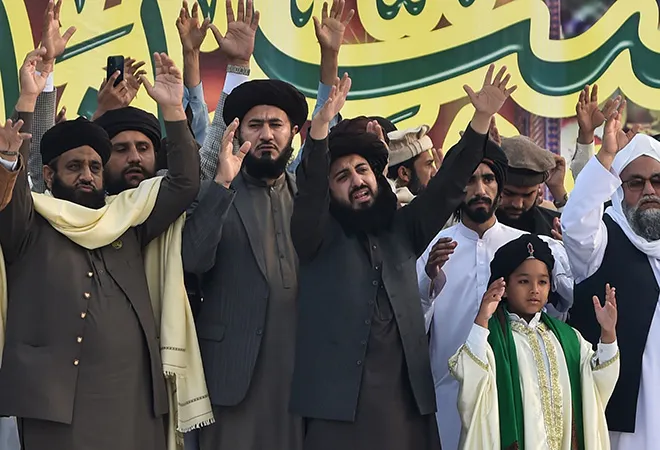
It is by now a fairly familiar script: The very aggressive cadres of the hard-line Barelvi religious political party
Tehrik-e-Labbaik Pakistan (TLP) work themselves into a frenzy over some emotional religious issue, take to the streets, clash with the law enforcers; the government at first threatens them with the wrath of the state and then cravenly capitulates, in part because the ‘deep state’ and ‘establishment’ doesn’t back using force against the fulminating fanatics; the government buys temporary peace by giving in to the TLP demands; but since the government has no intention of meeting the more onerous demands, the stage is set for the next round of confrontation. After each cave in by the government, the TLP gains more strength and support, and the state seems to shrivel up in front of the zealots. The few times the state asserted itself and demonstrated its power, it didn’t have the stomach for cutting the TLP to size. The result: The TLP bounced back with greater vigour, vehemence and virulence.
Reports in the Pakistani media claim that while the government wanted to act firmly against the TLP, and was ready to use force, the army wasn’t ready to fire on the Namoos-e-Risalat march of TLP from Lahore to Islamabad.
Against this backdrop, the latest
surrender by the Pakistani state before the TLP was not surprising; but the manner in which the government succumbed before the TLP was. The terms of the agreement between the government and TLP are believed to be so one-sided in favour of the latter that they have been kept secret. Interestingly, like in the past, these humiliating terms of surrender were midwifed by the Pakistan Army, but only after the government was shown up as being all at sea on how to handle the March. The constant
blow-hot-
blow-cold of the government towards the marchers had already sent out confused signals about the intention of the government. After the police failed to stop the March, the Army-led
Rangers were called in to control the situation. This meant that the entire burden of any action taken against the TLP would fall on the Army.
The
spat between the army and the government over the appointment of the new ISI chief, had already created a serious trust deficit between the civilian government and the military establishment. The latter felt that if things went out of control, the Imran Khan government would make the Army the fall guy. The army was, therefore,
not ready to fire on the
Namoos-e-Risalat March of TLP from Lahore to Islamabad. Even after the government decided it wanted to
act firmly against the TLP and even use force, the military counselled the government to throw in the towel, which it did.
Objectively speaking, once the TLP embarked on the March and managed to
break through the barriers and obstructions placed along the route by the police, the authorities were left with only three options—all of them bad. The first was to stop the Marchers from proceeding towards Islamabad, using all the necessary force available. Normal policing methods—teargas, lathi charge, etc.—had already been tried, and they had failed. The only way to stop this highly charged crowd was to fire into them. This would mean large number of casualties, all captured on video and going viral, not just in Pakistan but around the world. The repercussions of this were unimaginable. It raised the spectre of another Lal Masjid, when, in 2007, Pakistan Army commandos carried out an operation against well entrenched Islamists holed up in the mosque in Islamabad. That operation sounded the death knell of the Musharraf regime. Worse, it led to the jihadists coming together under the umbrella of Tehrik-e-Taliban Pakistan (TTP). Since that fateful day, Pakistan has faced the blowback of jihadists waging war against the Pakistani state. A similar incident, this time against a crowd that was ostensibly agitating for the honour of the Prophet, could have unimaginable consequences, and that too in the heartland of Pakistan—Punjab. The reluctance of the Army in precipitating such a crisis is quite understandable.
Firing into a religiously motivated crowd and that too in Islamabad would have been an even bigger disaster than firing into the same crowd in some relatively obscure place like Sadoke or Wazirabad.
The second option was to step aside and let the Marchers proceed to Islamabad. But there was no guarantee that once the crowd reached Islamabad it wouldn’t run amok in the capital. If that happened, the authorities would have no option but to use force, ending up doing precisely what they were trying to avoid in the first place. Firing into a religiously motivated crowd and that too in Islamabad would have been an even bigger disaster than firing into the same crowd in some relatively obscure place like Sadoke or Wazirabad. On the other hand, if the Rangers and police let the crowd run amok, the visuals of these zealots destroying public property or targeting diplomatic establishments would have proved ruinous for Pakistan and its Army. Clearly, this wasn’t a realistic option.
That left the third option—capitulation. Basically, this meant release of all activists, withdrawal of cases and restrictions imposed on activists, revocation of the proscription on the organisation and not imposing any ban on its political activities, releasing its leader who has been kept under preventive detention for over eight months, and taking the issue of expulsion of the French embassy before parliament. By giving in to these demands, the government would tide over the immediate crisis, and live to fight another day. No doubt, the optics of this option look terrible for the government, which is seen as having thrown in the towel. Pakistan’s image, already nothing to write home about, has taken a terrible beating. The TLP, which has managed to bring the government to its knees, has gained enormously. It has been both empowered and emboldened to a dangerous level. The message to other organisations and groups is that if they can manage to rustle up fairly large numbers of motivated crowds, they can get away with murder—TLP marchers are alleged to have killed more than half a dozen Pakistani policemen and have gotten away scot-free. The police services are completely demoralised. Not only do they feel
abandoned by the political masters, but also terrorised by the ‘wretched of the earth’ who form the bulk of the TLP support base.
The JKLF was cut to size by raising the Hizbul Mujahideen and later Hizb was kept as a show-boy even as most of the operations in Jammu and Kashmir were outsourced to Pakistani terrorist groups like Lashkar-e-Taiba and Jaish.
The TLP has emerged as the clear victor from this latest round of confrontation with the government. But the path ahead is not going to be very smooth, certainly not if the army can help it. The movement has acquired frightening proportions that would certainly be spooking the military. For now, the military retains its primacy. As recent events have shown, the TLP hasn’t really challenged the Army. In fact, it has sought guarantees from the Army on the deal it struck with the government. Even so, for the Army, the TLP poses a dilemma. On the one hand, it is a handy tool to be deployed not just to bring governments under pressure but also influence the outcome of elections and government formation; but on the other hand, as the ultimate arbiter and underwriter of the state, the Pakistan Army cannot allow such a group, movement or party to become so big that it becomes unmanageable and has the potential to destabilise the government and the state.
The military establishment is, therefore, going to be left with no choice except to cut the TLP down to size. The Pakistan Army has a lot of experience in this sort of thing. It never allowed any Islamist group to become so large that it posed a threat to the state. Before any group became a threat to the state, the army would engineer splits and divide these groups, or raise counter groups. If, however, a group did become so big that it threatened the state and the Army, then it would be ruthlessly crushed. Something along similar lines could happen with the TLP.
Saad Rizvi remains top dog in TLP. But his leadership will be put to test as will his ability to keep his flock together and make it grow.
Even the TLP was split into three factions. The problem, however, was that the breakaway factions led by
Ashraf Jalali and
Pir Afzal Qadri never really got much traction from the cadre. But this doesn’t mean that these efforts will not be redoubled going forward. For now, Saad Rizvi remains top dog in TLP. But his leadership will be put to test as will his ability to keep his flock together and make it grow. The challenge will come both from within the organisation and from the larger Barelvi fraternity. The
meeting between Imran Khan and nearly 20 top Barelvi clerics (most of them who have had their thunder stolen from under them by the TLP’s now deceased founder Khadim Rizvi) is probably a step in that direction. There will be other more hidden efforts underway to split TLP from within by wooing some of the top leaders.
The problem is that even if the Pakistani state is successful in either engineering a split or building up Barelvi counters to TLP’s growing power, it will not be able to bottle up the genie of extremism that the TLP embodies. If anything, it will get worse because splinter groups tend to engage in competitive fanaticism with the parent body, and are ideologically more rigid. Therefore, even though the TLP might be weakened, extremism will be strengthened. This, too, has been the experience with the splits engineered in other Islamist groups. Things will only be made worse by mainstream political parties trying to cut political deals with these extremists to gain electoral advantage. Bottom-line: The phenomenon that the TLP represents is here to stay, and grow.
The views expressed above belong to the author(s). ORF research and analyses now available on Telegram! Click here to access our curated content — blogs, longforms and interviews.



 It is by now a fairly familiar script: The very aggressive cadres of the hard-line Barelvi religious political party
It is by now a fairly familiar script: The very aggressive cadres of the hard-line Barelvi religious political party  PREV
PREV


